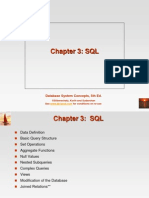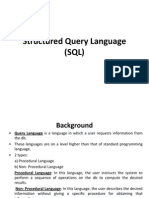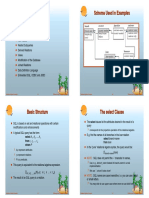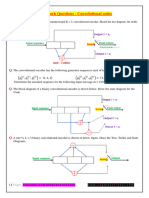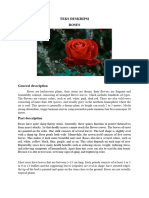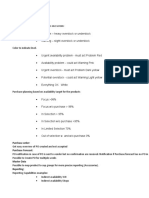I.S.C. E.D. M.E.: Ricardo de Jesús Bustamante González
Uploaded by
Erick Sebastiao De LozanoI.S.C. E.D. M.E.: Ricardo de Jesús Bustamante González
Uploaded by
Erick Sebastiao De LozanoChapter 3
I.S.C. E.D. M.E.
Ricardo de Jess
Bustamante Gonzlez
Catedrtico
Universitario
Instituto Tecnolgico
Superior de Lerdo
Divisin de Informtica
I.S.C. E.D. M.E. Ricardo de Jess Bustamante Gonzlez
Chapter 3: SQL Chapter 3: SQL
Data Definition
Basic Query Structure
Set Operations
Aggregate Functions
Null Values
Nested Subqueries
Complex Queries
Views
Modification of the Database
Joined Relations**
I.S.C. E.D. M.E. Ricardo de Jess Bustamante Gonzlez
Chapter 3: SQL
History
IBM Sequel language developed as part of System R
project at the IBM San Jose Research Laboratory
Renamed Structured Query Language (SQL)
ANSI and ISO standard SQL:
SQL-86
SQL-89
SQL-92
SQL:1999 (language name became Y2K compliant!)
SQL:2003
Commercial systems offer most, if not all, SQL-92 features,
plus varying feature sets from later standards and special
proprietary features.
Not all examples here may work on your particular system.
I.S.C. E.D. M.E. Ricardo de Jess Bustamante Gonzlez
Chapter 3: SQL
Data Definition Language
The schema for each relation, including attribute
types.
Integrity constraints
Authorization information for each relation.
Non-standard SQL extensions also allow
specification of
The set of indices to be maintained for each relations.
The physical storage structure of each relation on disk.
Allows the specification of:
I.S.C. E.D. M.E. Ricardo de Jess Bustamante Gonzlez
Chapter 3: SQL
Create Table Construct
An SQL relation is defined using the create table
command:
create table r (A
1
D
1
, A
2
D
2
, ..., A
n
D
n
,
(integrity-constraint
1
),
...,
(integrity-constraint
k
))
r is the name of the relation
each A
i
is an attribute name in the schema of relation r
D
i
is the data type of attribute A
i
Example:
create table branch
(branch_name char(15),
branch_city char(30),
assets integer)
I.S.C. E.D. M.E. Ricardo de Jess Bustamante Gonzlez
Chapter 3: SQL
Domain Types in SQL
char(n). Fixed length character string, with user-
specified length n.
varchar(n). Variable length character strings, with
user-specified maximum length n.
int. Integer (a finite subset of the integers that is
machine-dependent).
smallint. Small integer (a machine-dependent subset
of the integer domain type).
numeric(p,d). Fixed point number, with user-specified
precision of p digits, with n digits to the right of
decimal point.
real, double precision. Floating point and double-
precision floating point numbers, with machine-
dependent precision.
float(n). Floating point number, with user-specified
precision of at least n digits.
More are covered in Chapter 4.
I.S.C. E.D. M.E. Ricardo de Jess Bustamante Gonzlez
Chapter 3: SQL
Integrity Constraints on Tables
not null
primary key (A
1
, ..., A
n
)
Example: Declare branch_name as the primary key for branch
.
create table branch
(branch_name char(15),
branch_city char(30) not null,
assets integer,
primary key (branch_name))
primary key declaration on an attribute automatically ensures
not null in SQL-92 onwards, needs to be explicitly stated in
SQL-89
I.S.C. E.D. M.E. Ricardo de Jess Bustamante Gonzlez
Chapter 3: SQL
Basic Insertion and Deletion of
Tuples
Newly created table is empty
Add a new tuple to account
insert into account
values ('A-9732', 'Perryridge', 1200)
Insertion fails if any integrity constraint is violated
Delete all tuples from account
delete from account
Note: Will see later how to delete selected tuples
I.S.C. E.D. M.E. Ricardo de Jess Bustamante Gonzlez
Chapter 3: SQL
Drop and Alter Table Constructs
The drop table command deletes all information about
the dropped relation from the database.
The alter table command is used to add attributes to an
existing relation:
alter table r add A D
where A is the name of the attribute to be added to
relation r and D is the domain of A.
All tuples in the relation are assigned null as the value for
the new attribute.
The alter table command can also be used to drop
attributes of a relation:
alter table r drop A
where A is the name of an attribute of relation r
Dropping of attributes not supported by many databases
I.S.C. E.D. M.E. Ricardo de Jess Bustamante Gonzlez
Chapter 3: SQL
Basic Query Structure
A typical SQL query has the form:
select A
1
, A
2
, ..., A
n
from r
1
, r
2
, ..., r
m
where P
A
i
represents an attribute
R
i
represents a relation
P is a predicate.
This query is equivalent to the relational algebra
expression.
The result of an SQL query is a relation.
)) ( (
2 1 , , ,
2 1
m P A A A
r r r
n
[
o
I.S.C. E.D. M.E. Ricardo de Jess Bustamante Gonzlez
Chapter 3: SQL
The select Clause
The select clause list the attributes desired in the result of a
query
corresponds to the projection operation of the relational
algebra
Example: find the names of all branches in the loan
relation:
select branch_name
from loan
In the relational algebra, the query would be:
[
branch_name
(loan)
NOTE: SQL names are case insensitive (i.e., you may use
upper- or lower-case letters.)
E.g. Branch_Name BRANCH_NAME branch_name
Some people use upper case wherever we use bold font.
I.S.C. E.D. M.E. Ricardo de Jess Bustamante Gonzlez
Chapter 3: SQL
The select Clause (Cont.)
SQL allows duplicates in relations as well as in query results.
To force the elimination of duplicates, insert the keyword
distinct after select.
Find the names of all branches in the loan relations, and
remove duplicates
select distinct branch_name
from loan
The keyword all specifies that duplicates not be removed.
select all branch_name
from loan
I.S.C. E.D. M.E. Ricardo de Jess Bustamante Gonzlez
Chapter 3: SQL
The select Clause (Cont.)
An asterisk in the select clause denotes all attributes
select *
from loan
The select clause can contain arithmetic expressions
involving the operation, +, , -, and /, and operating
on constants or attributes of tuples.
E.g.:
select loan_number, branch_name,
amount - 100
from loan
I.S.C. E.D. M.E. Ricardo de Jess Bustamante Gonzlez
Chapter 3: SQL
The where Clause
The where clause specifies conditions that the
result must satisfy
Corresponds to the selection predicate of the
relational algebra.
To find all loan number for loans made at the
Perryridge branch with loan amounts greater
than $1200.
select loan_number
from loan
where branch_name = 'Perryridge' and
amount > 1200
Comparison results can be combined using the
logical connectives and, or, and not.
I.S.C. E.D. M.E. Ricardo de Jess Bustamante Gonzlez
Chapter 3: SQL
The from Clause
The from clause lists the relations involved in the query
Corresponds to the Cartesian product operation of the
relational algebra.
Find the Cartesian product borrower X loan
select -
from borrower, loan
Find the name, loan number and loan amount of all
customers having a loan at the Perryridge branch.
select customer_name, borrower.loan_number, amount
from borrower, loan
where borrower.loan_number = loan.loan_number and
branch_name = 'Perryridge'
I.S.C. E.D. M.E. Ricardo de Jess Bustamante Gonzlez
Chapter 3: SQL
The Rename Operation
SQL allows renaming relations and attributes using
the as clause:
old-name as new-name
E.g. Find the name, loan number and loan amount
of all customers; rename the column name
loan_number as loan_id.
select customer_name, borrower.loan_number as loan_id, amount
from borrower, loan
where borrower.loan_number = loan.loan_number
I.S.C. E.D. M.E. Ricardo de Jess Bustamante Gonzlez
Chapter 3: SQL
Tuple Variables
Tuple variables are defined in the from clause via the use
of the as clause.
Find the customer names and their loan numbers and
amount for all customers having a loan at some branch.
Find the names of all branches that have greater assets
than some branch located in Brooklyn.
select distinct T.branch_name
from branch as T, branch as S
where T.assets > S.assets and S.branch_city = 'Brooklyn'
Keyword as is optional and may be omitted
borrower as T borrower T
Some database such as Oracle require as to be omitted
select customer_name, T.loan_number, S.amount
from borrower as T, loan as S
where T.loan_number = S.loan_number
I.S.C. E.D. M.E. Ricardo de Jess Bustamante Gonzlez
Chapter 3: SQL
String Operations
SQL includes a string-matching operator for
comparisons on character strings. The operator
like uses patterns that are described using two
special characters:
percent (%). The % character matches any substring.
underscore (_). The _ character matches any character.
Find the names of all customers whose street
includes the substring Main.
select customer_name
from customer
where customer_street like '% Main%'
I.S.C. E.D. M.E. Ricardo de Jess Bustamante Gonzlez
Chapter 3: SQL
String Operations (Cont)
Match the name Main%
like 'Main\%' escape '\'
SQL supports a variety of string operations such as
concatenation (using ||)
converting from upper to lower case (and vice versa)
finding string length, extracting substrings, etc.
I.S.C. E.D. M.E. Ricardo de Jess Bustamante Gonzlez
Chapter 3: SQL
Ordering the Display of Tuples
List in alphabetic order the names of all customers
having a loan in Perryridge branch
select distinct customer_name
from borrower, loan
where borrower loan_number =
loan.loan_number and
branch_name = 'Perryridge'
order by customer_name
We may specify desc for descending order or asc
for ascending order, for each attribute; ascending
order is the default.
Example: order by customer_name desc
I.S.C. E.D. M.E. Ricardo de Jess Bustamante Gonzlez
Chapter 3: SQL
Set Operations
The set operations union, intersect, and except
operate on relations and correspond to the
relational algebra operations , , .
Each of the above operations automatically
eliminates duplicates; to retain all duplicates
use the corresponding multiset versions union
all, intersect all and except all.
Suppose a tuple occurs m times in r and n times
in s, then, it occurs:
m
+ n times in r union all s
min(m,n) times in r intersect all s
max(0, m n) times in r except all s
I.S.C. E.D. M.E. Ricardo de Jess Bustamante Gonzlez
Chapter 3: SQL
Set Operations
Find all customers who have a loan, an account, or both:
(select customer_name from depositor)
except
(select customer_name from borrower)
(select customer_name from depositor)
intersect
(select customer_name from borrower)
Find all customers who have an account but no loan.
(select customer_name from depositor)
union
(select customer_name from borrower)
Find all customers who have both a loan and an account.
I.S.C. E.D. M.E. Ricardo de Jess Bustamante Gonzlez
Chapter 3: SQL
Aggregate Functions
These functions operate on the multiset of
values of a column of a relation, and return a
value
avg: average value
min: minimum value
max: maximum value
sum: sum of values
count: number of values
I.S.C. E.D. M.E. Ricardo de Jess Bustamante Gonzlez
Chapter 3: SQL
Aggregate Functions (Cont.)
Find the average account balance at the Perryridge branch.
Find the number of depositors in the bank.
Find the number of tuples in the customer relation.
select avg (balance)
from account
where branch_name = 'Perryridge'
select count (*)
from customer
select count (distinct customer_name)
from depositor
I.S.C. E.D. M.E. Ricardo de Jess Bustamante Gonzlez
Chapter 3: SQL
Aggregate Functions Group By
Find the number of depositors for each branch.
Note: Attributes in select clause outside of aggregate functions must
appear in group by list
select branch_name, count (distinct customer_name)
from depositor, account
where depositor.account_number = account.account_number
group by branch_name
I.S.C. E.D. M.E. Ricardo de Jess Bustamante Gonzlez
Chapter 3: SQL
Aggregate Functions Having
Clause
Find the names of all branches where the
average account balance is more than $1,200.
Note: predicates in the having clause are applied after the
formation of groups whereas predicates in the where
clause are applied before forming groups
select branch_name, avg (balance)
from account
group by branch_name
having avg (balance) > 1200
I.S.C. E.D. M.E. Ricardo de Jess Bustamante Gonzlez
Chapter 3: SQL
Nested Subqueries
SQL provides a mechanism for the nesting of
subqueries.
A subquery is a select-from-where expression
that is nested within another query.
A common use of subqueries is to perform tests
for set membership, set comparisons, and set
cardinality.
I.S.C. E.D. M.E. Ricardo de Jess Bustamante Gonzlez
Chapter 3: SQL
In Construct
Find all customers who have both an account
and a loan at the bank.
Find all customers who have a loan at the
bank but do not have an account at the bank
select distinct customer_name
from borrower
where customer_name not in (select customer_name
from depositor )
select distinct customer_name
from borrower
where customer_name in (select customer_name
from depositor )
I.S.C. E.D. M.E. Ricardo de Jess Bustamante Gonzlez
Chapter 3: SQL
Example Query
Find all customers who have both an account
and a loan at the Perryridge branch
Note: Above query can be written in a much
simpler manner. The formulation above is simply
to illustrate SQL features.
select distinct customer_name
from borrower, loan
where borrower.loan_number = loan.loan_number and
branch_name = 'Perryridge' and
(branch_name, customer_name ) in
(select branch_name, customer_name
from depositor, account
where depositor.account_number =
account.account_number )
I.S.C. E.D. M.E. Ricardo de Jess Bustamante Gonzlez
Chapter 3: SQL
Some Construct
Find all branches that have greater assets than
some branch located in Brooklyn.
Same query using > some clause
select branch_name
from branch
where assets > some
(select assets
from branch
where branch_city = 'Brooklyn')
select distinct T.branch_name
from branch as T, branch as S
where T.assets > S.assets and
S.branch_city = 'Brooklyn'
I.S.C. E.D. M.E. Ricardo de Jess Bustamante Gonzlez
Chapter 3: SQL
All Construct
Find the names of all branches that have greater
assets than all branches located in Brooklyn.
select branch_name
from branch
where assets > all
(select assets
from branch
where branch_city = 'Brooklyn')
I.S.C. E.D. M.E. Ricardo de Jess Bustamante Gonzlez
Chapter 3: SQL
Exists Construct
Find all customers who have an account at all
branches located in Brooklyn.
select distinct S.customer_name
from depositor as S
where not exists (
(select branch_name
from branch
where branch_city = 'Brooklyn')
except
(select R.branch_name
from depositor as T, account as R
where T.account_number = R.account_number and
S.customer_name = T.customer_name ))
Note: Cannot write this query using = all and its variants
I.S.C. E.D. M.E. Ricardo de Jess Bustamante Gonzlez
Chapter 3: SQL
Absence of Duplicate Tuples
The unique construct tests whether a subquery
has any duplicate tuples in its result.
Find all customers who have at most one
account at the Perryridge branch.
select T.customer_name
from depositor as T
where unique (
select R.customer_name
from account, depositor as R
where T.customer_name =
R.customer_name and R.account_number =
account.account_number and
account.branch_name = 'Perryridge')
I.S.C. E.D. M.E. Ricardo de Jess Bustamante Gonzlez
Chapter 3: SQL
Example Query
Find all customers who have at least two
accounts at the Perryridge branch.
select distinct T.customer_name
from depositor as T
where not unique (
select R.customer_name
from account, depositor as R
where T.customer_name = R.customer_name and
R.account_number = account.account_number and
account.branch_name = 'Perryridge')
Variable from outer level is known as a
correlation variable
I.S.C. E.D. M.E. Ricardo de Jess Bustamante Gonzlez
Chapter 3: SQL
Modification of the Database
Deletion
Delete all account tuples at the Perryridge
branch
delete from account
where branch_name = 'Perryridge'
Delete all accounts at every branch located in
the city Needham.
delete from account
where branch_name in (select
branch_name
from branch
where branch_city = 'Needham')
I.S.C. E.D. M.E. Ricardo de Jess Bustamante Gonzlez
Chapter 3: SQL
Example Query
Delete the record of all accounts with balances
below the average at the bank.
delete from account
where balance < (select avg (balance )
from account )
Problem: as we delete tuples from deposit, the average balance
changes
Solution used in SQL:
1. First, compute avg balance and find all tuples to delete
2. Next, delete all tuples found above (without recomputing avg
or retesting the tuples)
I.S.C. E.D. M.E. Ricardo de Jess Bustamante Gonzlez
Chapter 3: SQL
Modification of the Database
Insertion
Add a new tuple to account
insert into account
values ('A-9732', 'Perryridge', 1200)
or equivalently
insert into account (branch_name, balance,
account_number)
values ('Perryridge', 1200, 'A-9732')
Add a new tuple to account with balance set to null
insert into account
values ('A-777','Perryridge', null )
I.S.C. E.D. M.E. Ricardo de Jess Bustamante Gonzlez
Chapter 3: SQL
Modification of the Database
Insertion
Provide as a gift for all loan customers of the Perryridge
branch, a $200 savings account. Let the loan number serve
as the account number for the new savings account
insert into account
select loan_number, branch_name, 200
from loan
where branch_name = 'Perryridge'
insert into depositor
select customer_name, loan_number
from loan, borrower
where branch_name = 'Perryridge'
and loan.account_number =
borrower.account_number
The select from where statement is evaluated fully before any
of its results are inserted into the relation
Motivation: insert into table1 select * from table1
I.S.C. E.D. M.E. Ricardo de Jess Bustamante Gonzlez
Chapter 3: SQL
Modification of the Database
Updates
Increase all accounts with balances over $10,000 by 6%, all
other accounts receive 5%.
Write two update statements:
update account
set balance = balance - 1.06
where balance > 10000
update account
set balance = balance - 1.05
where balance s 10000
The order is important
Can be done better using the case statement (next slide)
I.S.C. E.D. M.E. Ricardo de Jess Bustamante Gonzlez
Chapter 3: SQL
Case Statement for Conditional
Updates
Same query as before: Increase all accounts
with balances over $10,000 by 6%, all other
accounts receive 5%.
update account
set balance = case
when balance <= 10000 then balance * 1.05
else balance * 1.06 end
I.S.C. E.D. M.E. Ricardo de Jess Bustamante Gonzlez
Chapter 3: SQL
Joined Relations**
Join operations take two relations and return as a
result another relation.
These additional operations are typically used as
subquery expressions in the from clause
Join condition defines which tuples in the two
relations match, and what attributes are present in
the result of the join.
Join type defines how tuples in each relation that
do not match any tuple in the other relation (based
on the join condition) are treated.
I.S.C. E.D. M.E. Ricardo de Jess Bustamante Gonzlez
Chapter 3: SQL
Joined Relations Datasets for
Examples
Relation loan
Relation borrower
Note: borrower information missing for L-260 and
loan information missing for L-155
I.S.C. E.D. M.E. Ricardo de Jess Bustamante Gonzlez
Chapter 3: SQL
Joined Relations Examples
loan inner join borrower on
loan.loan_number = borrower.loan_number
loan left outer join borrower on
loan.loan_number = borrower.loan_number
I.S.C. E.D. M.E. Ricardo de Jess Bustamante Gonzlez
Chapter 3: SQL
Joined Relations Examples
loan natural inner join borrower
loan natural right outer join borrower
Find all customers who have either an account or
a loan (but not both) at the bank.
select customer_name
from (depositor natural full outer join borrower )
where account_number is null or loan_number is null
I.S.C. E.D. M.E. Ricardo de Jess Bustamante Gonzlez
Chapter 3: SQL
Joined Relations Examples
Find all customers who have either an account or
a loan (but not both) at the bank.
select customer_name
from (depositor natural full outer join borrower )
where account_number is null or loan_number is null
I.S.C. E.D. M.E. Ricardo de Jess Bustamante Gonzlez
Chapter 3: SQL
Joined Relations Examples
Natural join can get into trouble if two relations
have an attribute with same name that should
not affect the join condition
e.g. an attribute such as remarks may be present
in many tables
Solution:
loan full outer join borrower using (loan_number)
I.S.C. E.D. M.E. Ricardo de Jess Bustamante Gonzlez
Chapter 3: SQL
Derived Relations
SQL allows a subquery expression to be used in the from
clause
Find the average account balance of those branches
where the average account balance is greater than
$1200.
select branch_name, avg_balance
from (select branch_name, avg (balance)
from account
group by branch_name )
as branch_avg ( branch_name, avg_balance )
where avg_balance > 1200
Note that we do not need to use the having clause, since
we compute the temporary (view) relation branch_avg in
the from clause, and the attributes of branch_avg can be
used directly in the where clause.
I.S.C. E.D. M.E. Ricardo de Jess Bustamante Gonzlez
Chapter 3: SQL
View Definition
A relation that is not of the conceptual model
but is made visible to a user as a virtual
relation is called a view.
A view is defined using the create view
statement which has the form
create view v as < query expression >
where <query expression> is any legal SQL
expression. The view name is represented by v.
Once a view is defined, the view name can be
used to refer to the virtual relation that the view
generates.
I.S.C. E.D. M.E. Ricardo de Jess Bustamante Gonzlez
Chapter 3: SQL
Example Queries
A view consisting of branches and their customers
Find all customers of the Perryridge branch
create view all_customer as
(select branch_name, customer_name
from depositor, account
where depositor.account_number =
account.account_number )
union
(select branch_name, customer_name
from borrower, loan
where borrower.loan_number = loan.loan_number )
select customer_name
from all_customer
where branch_name = 'Perryridge'
I.S.C. E.D. M.E. Ricardo de Jess Bustamante Gonzlez
Chapter 3: SQL
Uses of Views
Hiding some information from some users
Consider a user who needs to know a customers
name, loan number and branch name, but has no
need to see the loan amount.
Define a view
(create view cust_loan_data as
select customer_name,
borrower.loan_number,
branch_name from borrower, loan
where borrower.loan_number =
loan.loan_number )
Grant the user permission to read cust_loan_data,
but not borrower or loan
I.S.C. E.D. M.E. Ricardo de Jess Bustamante Gonzlez
Chapter 3: SQL
Uses of Views
Predefined queries to make writing of other
queries easier
Common example: Aggregate queries used for
statistical analysis of data
I.S.C. E.D. M.E. Ricardo de Jess Bustamante Gonzlez
Chapter 3: SQL
Processing of Views
When a view is created
the query expression is stored in the database along
with the view name
the expression is substituted into any query using the
view
Views definitions containing views
One view may be used in the expression defining
another view
A view relation v
1
is said to depend directly on a view
relation v
2
if v
2
is used in the expression defining v
1
A view relation v
1
is said to depend on view relation v
2
if
either v
1
depends directly to v
2
or there is a path of
dependencies from v
1
to v
2
A view relation v is said to be recursive if it depends on
itself.
I.S.C. E.D. M.E. Ricardo de Jess Bustamante Gonzlez
Chapter 3: SQL
View Expansion
A way to define the meaning of views defined in terms
of other views.
Let view v
1
be defined by an expression e
1
that may
itself contain uses of view relations.
View expansion of an expression repeats the following
replacement step:
Repeat
Find any view relation v
i
in e
1
Replace the view relation v
i
by the expression
defining v
i
until no more view relations are present
in e
1
As long as the view definitions are not recursive, this
loop will terminate
I.S.C. E.D. M.E. Ricardo de Jess Bustamante Gonzlez
Chapter 3: SQL
With Clause
The with clause provides a way of defining a
temporary view whose definition is available
only to the query in which the with clause
occurs.
Find all accounts with the maximum balance
with max_balance (value) as
select max (balance)
from account
select account_number
from account, max_balance
where account.balance =
max_balance.value
I.S.C. E.D. M.E. Ricardo de Jess Bustamante Gonzlez
Chapter 3: SQL
Complex Queries using With Clause
Find all branches where the total account deposit is
greater than the average of the total account
deposits at all branches.
with branch_total (branch_name, value) as
select branch_name, sum (balance)
from account
group by branch_name
with branch_total_avg (value) as
select avg (value)
from branch_total
select branch_name
from branch_total, branch_total_avg
where branch_total.value >= branch_total_avg.value
I.S.C. E.D. M.E. Ricardo de Jess Bustamante Gonzlez
Chapter 3: SQL
Complex Queries using With Clause
Note: the exact syntax supported by your database
may vary slightly.
E.g. Oracle syntax is of the form
with branch_total as ( select .. ),
branch_total_avg as ( select .. )
select
I.S.C. E.D. M.E. Ricardo de Jess Bustamante Gonzlez
Chapter 3: SQL
Update of a View
Create a view of all loan data in the loan relation,
hiding the amount attribute
create view loan_branch as
select loan_number, branch_name
from loan
Add a new tuple to loan_branch
insert into loan_branch
values ('L-37, 'Perryridge)
This insertion must be represented by the insertion of
the tuple ('L-37', 'Perryridge', null ) into the loan relation
I.S.C. E.D. M.E. Ricardo de Jess Bustamante Gonzlez
Chapter 3: SQL
Updates Through Views (Cont.)
Some updates through views are impossible to
translate into updates on the database relations
create view v as
select loan_number, branch_name, amount
from loan
where branch_name = Perryridge
insert into v values ( 'L-99','Downtown', '23')
Others cannot be translated uniquely
insert into all_customer values ('Perryridge', 'John')
Have to choose loan or account, and create a new
loan/account number!
Most SQL implementations allow updates only on
simple views (without aggregates) defined on a
single relation
I.S.C. E.D. M.E. Ricardo de Jess Bustamante Gonzlez
Chapter 3: SQL
Null Values
It is possible for tuples to have a null value, denoted
by null, for some of their attributes
null signifies an unknown value or that a value does
not exist.
The predicate is null can be used to check for null
values.
Example: Find all loan number which appear in the
loan relation with null values for amount.
select loan_number
from loan
where amount is null
The result of any arithmetic expression involving null is
null
Example: 5 + null returns null
However, aggregate functions simply ignore nulls
More on next slide
I.S.C. E.D. M.E. Ricardo de Jess Bustamante Gonzlez
Chapter 3: SQL
Null Values and Three Valued Logic
Any comparison with null returns unknown
Example: 5 < null or null <> null or null = null
Three-valued logic using the truth value unknown:
OR: (unknown or true) = true,
(unknown or false) = unknown
(unknown or unknown) = unknown
AND: (true and unknown) = unknown,
(false and unknown) = false,
(unknown and unknown) = unknown
NOT: (not unknown) = unknown
P is unknown evaluates to true if predicate P
evaluates to unknown
Result of where clause predicate is treated as false if
it evaluates to unknown
I.S.C. E.D. M.E. Ricardo de Jess Bustamante Gonzlez
Chapter 3: SQL
Null Values and Aggregates
Total all loan amounts
select sum (amount )
from loan
Above statement ignores null amounts
Result is null if there is no non-null amount
All aggregate operations except count(*)
ignore tuples with null values on the
aggregated attributes.
I.S.C. E.D. M.E. Ricardo de Jess Bustamante Gonzlez
Chapter 3: SQL
The where Clause (Cont.)
SQL includes a between comparison operator
Example: Find the loan number of those loans
with loan amounts between $90,000 and $100,000
(that is, > $90,000 and s $100,000)
select loan_number
from loan
where amount between 90000 and 100000
I.S.C. E.D. M.E. Ricardo de Jess Bustamante Gonzlez
Chapter 3: SQL
Figure 3.1: Database Schema
branch (branch_name, branch_city, assets)
customer (customer_name, customer_street,
customer_city)
loan (loan_number, branch_name, amount)
borrower (customer_name, loan_number)
account (account_number, branch_name, balance)
depositor (customer_name, account_number)
I.S.C. E.D. M.E. Ricardo de Jess Bustamante Gonzlez
Chapter 3: SQL
Definition of Some Clause
(= some) in
However, (= some) is not equivalent to not in
0
5
0
5 (5 = some ) = true (since 0 = 5)
) = true (5 = some
I.S.C. E.D. M.E. Ricardo de Jess Bustamante Gonzlez
Chapter 3: SQL
Definition of all Clause
(= all) not in
However, (= all) is not equivalent to in
0
5
6
(5 < all ) = false
6
10
4
) = true
5
4
6 (5 = all
) = true (since 5 = 4 and 5 = 6)
(5 < all
) = false (5 = all
I.S.C. E.D. M.E. Ricardo de Jess Bustamante Gonzlez
Chapter 3: SQL
Test for Empty Relations
The exists construct returns the value true if the
argument subquery is nonempty.
exists r r =
not exists r r =
Chapter 3: SQL
Figure 3.3: Tuples inserted into loan
and borrower
Chapter 3: SQL
Figure 3.4: The loan and borrower
relations
You might also like
- Database Systems Concept 5th Edition Silberschatz KorthNo ratings yetDatabase Systems Concept 5th Edition Silberschatz Korth68 pages
- Where To Find Free Cosmetic Formulas 10.08.2012100% (3)Where To Find Free Cosmetic Formulas 10.08.201214 pages
- Chapter 3: SQL: Database System Concepts, 5th EdNo ratings yetChapter 3: SQL: Database System Concepts, 5th Ed66 pages
- Database Management System: DDL and DDL and Tuple Tuple Calculus CalculusNo ratings yetDatabase Management System: DDL and DDL and Tuple Tuple Calculus Calculus16 pages
- Advance Database Systems - Lec 6 SQL (1)No ratings yetAdvance Database Systems - Lec 6 SQL (1)68 pages
- Database System Concepts, 5th Ed: ©silberschatz, Korth and Sudarshan See For Conditions On Re-UseNo ratings yetDatabase System Concepts, 5th Ed: ©silberschatz, Korth and Sudarshan See For Conditions On Re-Use72 pages
- Dr. M. Brindha Assistant Professor Department of CSE NIT, Trichy-15No ratings yetDr. M. Brindha Assistant Professor Department of CSE NIT, Trichy-1575 pages
- SQL Concepts: Krishnadas Manakotte Vivek VermaNo ratings yetSQL Concepts: Krishnadas Manakotte Vivek Verma53 pages
- Chapter 4: SQL: ©silberschatz, Korth and Sudarshan 4.1 Database System ConceptsNo ratings yetChapter 4: SQL: ©silberschatz, Korth and Sudarshan 4.1 Database System Concepts98 pages
- Comp 5311 Database Management Systems: 3. Structured Query Language 1No ratings yetComp 5311 Database Management Systems: 3. Structured Query Language 127 pages
- Introduction! Select-From-Where Statements! Queries Over Several Relations! Subqueries!No ratings yetIntroduction! Select-From-Where Statements! Queries Over Several Relations! Subqueries!71 pages
- 02-Introduction To Relational Model and SQL-SCDNo ratings yet02-Introduction To Relational Model and SQL-SCD50 pages
- SQL-99: Schema Definition, Basic Constraints, and Queries100% (1)SQL-99: Schema Definition, Basic Constraints, and Queries92 pages
- Hydraulic Mining Excavator CAT 6015: 06. Servo System100% (1)Hydraulic Mining Excavator CAT 6015: 06. Servo System26 pages
- AP Inter 2nd Year Syllabus 2020-21 - MATHEMATICS - 2B100% (1)AP Inter 2nd Year Syllabus 2020-21 - MATHEMATICS - 2B3 pages
- Non-Normal Incidence of Waves at Interfaces: in This Lecture You Will LearnNo ratings yetNon-Normal Incidence of Waves at Interfaces: in This Lecture You Will Learn11 pages
- SABIC® PP - 412MK49 - Global - Technical - Data - SheetNo ratings yetSABIC® PP - 412MK49 - Global - Technical - Data - Sheet2 pages
- Chapter 4- Design of Tension Members(1)No ratings yetChapter 4- Design of Tension Members(1)41 pages
- Accomplishment Report - Graduate School SECOND SEM AY 2021-22No ratings yetAccomplishment Report - Graduate School SECOND SEM AY 2021-2210 pages
- Short Adventures HD 02 SOLUTION Le Reveil de La Momie en (4)No ratings yetShort Adventures HD 02 SOLUTION Le Reveil de La Momie en (4)4 pages













